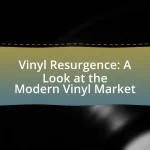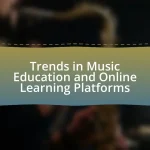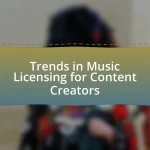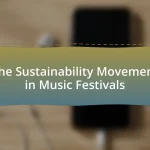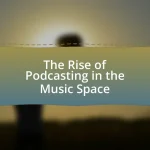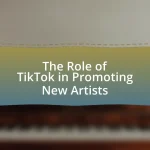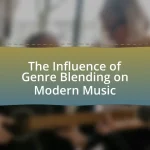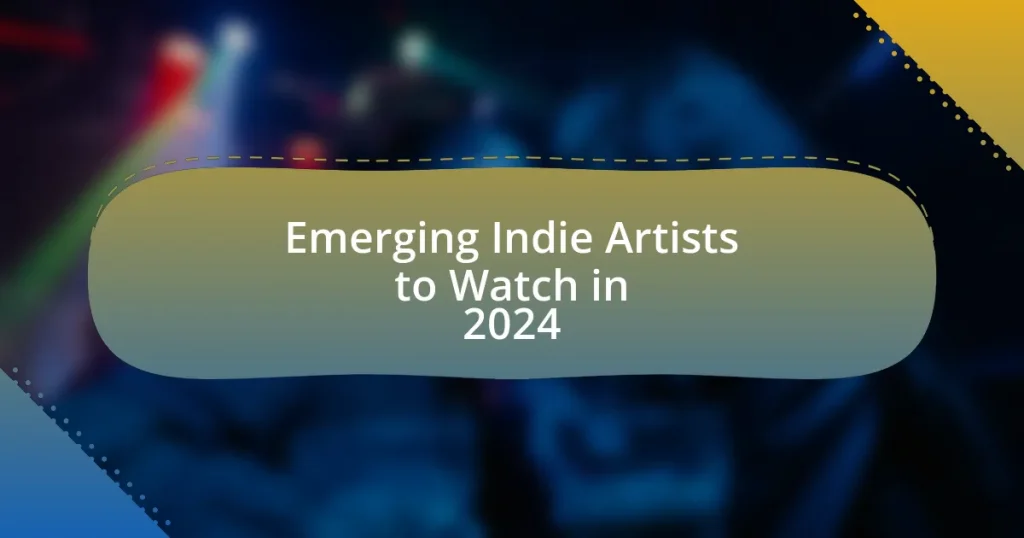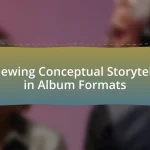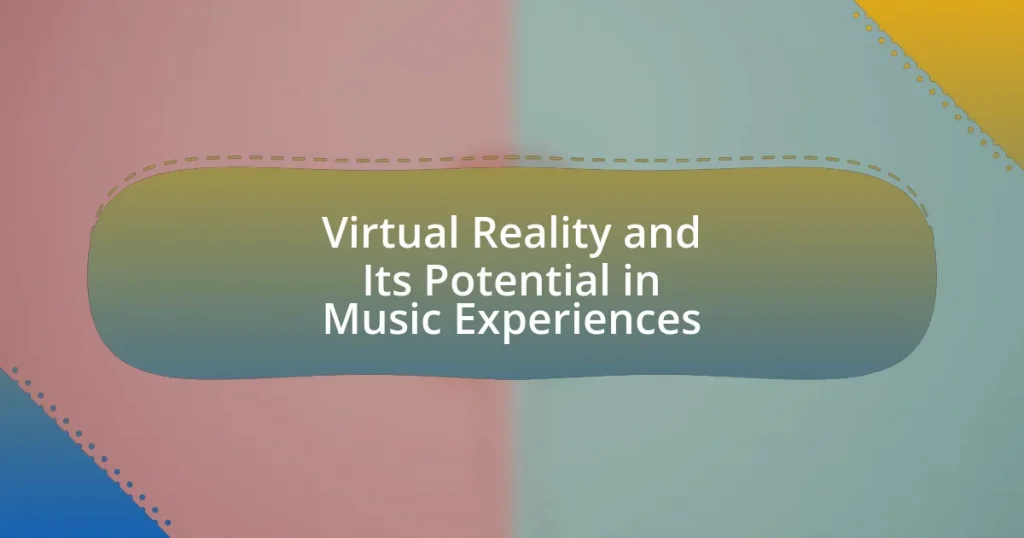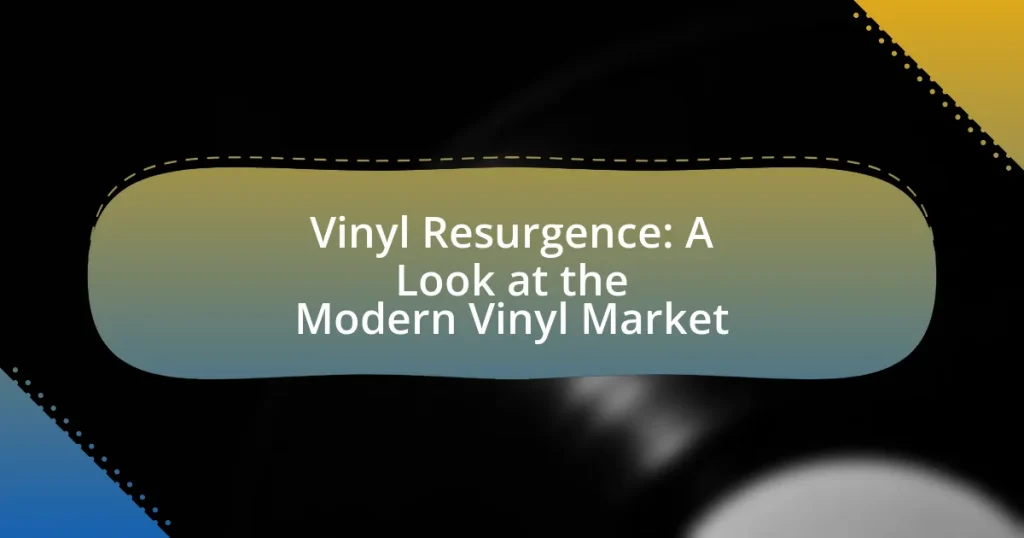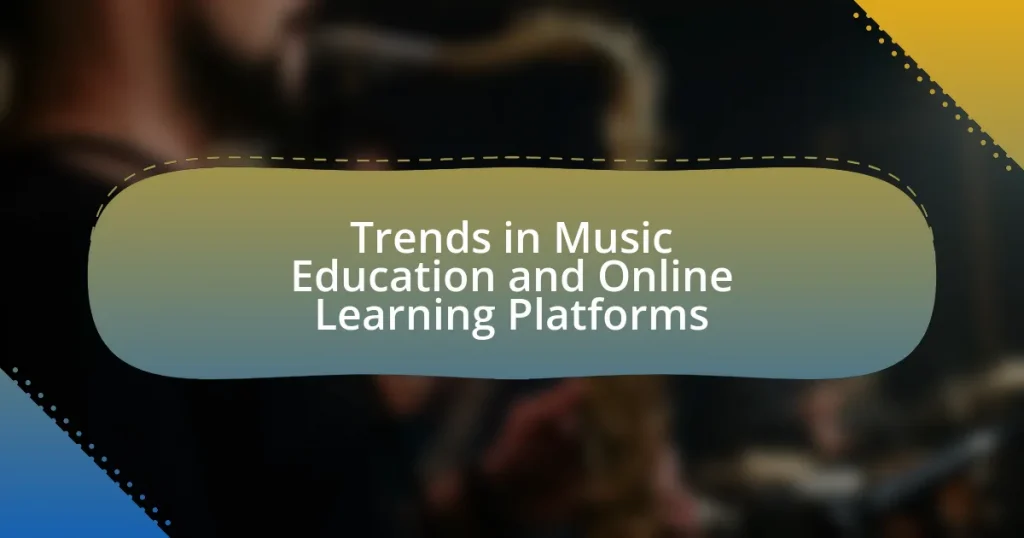The article focuses on emerging indie artists to watch in 2024, highlighting notable figures such as Ethel Cain, Yves Tumor, Snail Mail, and Arlo Parks, who are gaining recognition for their unique sounds and storytelling abilities. It defines emerging indie artists as those who create resonant music while leveraging digital platforms for promotion, and discusses the characteristics that set them apart, including genre fluidity and engagement with audiences. The piece also examines the trends influencing their rise, the importance of supporting these artists, and the challenges they face in a competitive landscape. Key platforms for discovering new talent, the impact of collaborations, and practical tips for fans to support indie musicians are also addressed.
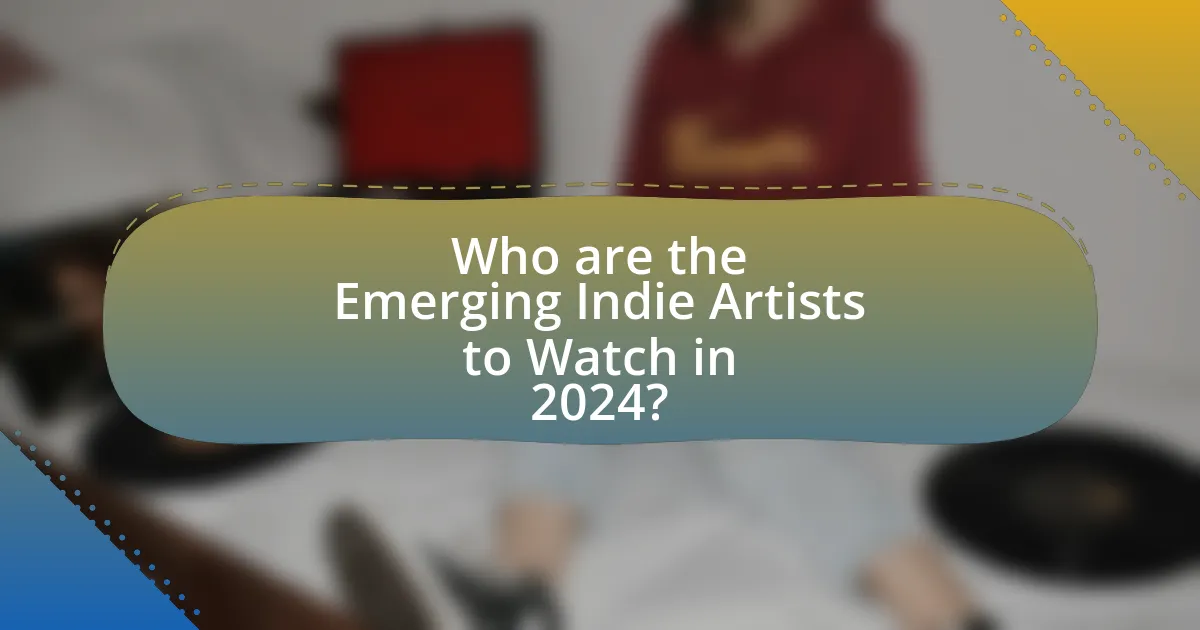
Who are the Emerging Indie Artists to Watch in 2024?
The emerging indie artists to watch in 2024 include artists like Ethel Cain, who gained recognition for her unique blend of genres and storytelling in music, and Yves Tumor, known for their experimental sound and captivating performances. Additionally, artists such as Snail Mail, who has been praised for her introspective lyrics and melodic guitar work, and Arlo Parks, celebrated for her poetic songwriting and soulful voice, are also making significant strides in the indie music scene. These artists have garnered attention through critical acclaim, festival appearances, and growing fan bases, indicating their potential for breakout success in the coming year.
What defines an emerging indie artist in 2024?
An emerging indie artist in 2024 is defined by their ability to create unique music that resonates with niche audiences while leveraging digital platforms for distribution and promotion. These artists typically have a growing online presence, often utilizing social media and streaming services to connect with fans and showcase their work. According to a report by MIDiA Research, independent artists accounted for 30% of global music revenues in 2023, highlighting the increasing viability of indie musicians in the mainstream market. Additionally, emerging indie artists often experiment with diverse genres and collaborate across artistic boundaries, reflecting a trend towards genre fluidity in contemporary music.
How do we identify the characteristics of these artists?
We identify the characteristics of emerging indie artists by analyzing their unique musical styles, lyrical themes, and engagement with their audience. These artists often showcase a blend of genres, reflecting personal influences and cultural backgrounds, which can be observed in their discography and live performances. Additionally, their lyrics frequently address contemporary issues, resonating with listeners on a personal level. Engagement metrics, such as social media interactions and streaming statistics, further highlight their connection with fans and the authenticity of their artistic expression.
What trends are influencing the rise of indie artists this year?
The rise of indie artists this year is primarily influenced by the increasing accessibility of digital platforms for music distribution and promotion. With platforms like Spotify, Bandcamp, and social media, artists can reach global audiences without the need for traditional record labels. Additionally, the trend of DIY production has empowered artists to create high-quality music at lower costs, further contributing to their independence. According to a report by MIDiA Research, indie music consumption has grown by 25% in the past year, highlighting the shift towards independent artistry in the music industry.
Why is it important to pay attention to emerging indie artists?
Paying attention to emerging indie artists is important because they often bring fresh perspectives and innovative sounds to the music industry. These artists frequently challenge mainstream norms, contributing to the diversity of musical expression. For instance, a report by the Music Industry Research Association indicates that indie artists have seen a 30% increase in streaming revenue over the past five years, highlighting their growing influence and the demand for unique content. Additionally, supporting emerging talent fosters a more inclusive music ecosystem, allowing for a wider range of voices and stories to be heard.
What impact do these artists have on the music industry?
Emerging indie artists significantly influence the music industry by introducing innovative sounds and diverse perspectives. These artists often challenge mainstream norms, leading to the evolution of genres and the emergence of new trends. For instance, the rise of platforms like Bandcamp and SoundCloud has enabled indie artists to reach global audiences without traditional label support, reshaping distribution models. Additionally, their grassroots marketing strategies often engage communities and foster loyal fan bases, which can drive sales and streaming numbers. This shift has been evidenced by the increasing number of indie artists charting on Billboard, indicating their growing impact on mainstream music consumption.
How do emerging indie artists shape musical trends and genres?
Emerging indie artists shape musical trends and genres by introducing innovative sounds and diverse influences that challenge mainstream conventions. These artists often blend various genres, such as folk, electronic, and hip-hop, creating unique styles that resonate with niche audiences. For instance, artists like Phoebe Bridgers and Sufjan Stevens have incorporated elements from different musical traditions, leading to the rise of sub-genres like indie folk and bedroom pop. Their success on platforms like Spotify and Bandcamp demonstrates how indie artists can gain traction and influence broader musical landscapes, as evidenced by the increasing number of indie tracks appearing on mainstream charts.
What are the key platforms for discovering new indie talent in 2024?
The key platforms for discovering new indie talent in 2024 include Bandcamp, SoundCloud, TikTok, and Spotify. Bandcamp allows artists to sell their music directly to fans, fostering a community that supports indie musicians. SoundCloud provides a space for artists to upload and share their tracks, often leading to viral hits. TikTok has become a powerful tool for music discovery, with trends often propelling indie songs into mainstream popularity. Spotify’s curated playlists, such as “Fresh Finds,” highlight emerging artists and facilitate their reach to wider audiences. These platforms collectively enhance visibility and accessibility for indie talent in the current music landscape.
Which streaming services are best for finding emerging artists?
Spotify and SoundCloud are the best streaming services for finding emerging artists. Spotify’s “Discover Weekly” and “Release Radar” playlists curate new music tailored to user preferences, often featuring up-and-coming artists. SoundCloud is known for its user-generated content, allowing independent musicians to upload their tracks and gain exposure, making it a hotspot for discovering fresh talent. Both platforms have algorithms and community features that support the visibility of emerging artists, thus enhancing the chances of finding new music.
How do social media platforms contribute to the visibility of indie artists?
Social media platforms significantly enhance the visibility of indie artists by providing them with accessible channels to reach a global audience. These platforms, such as Instagram, TikTok, and Twitter, allow artists to share their music, engage with fans, and promote their work without the need for traditional record label support. For instance, TikTok has become a powerful tool for music discovery, with 67% of users reporting that they discover new artists through the app, according to a 2021 report by TikTok itself. Additionally, social media enables indie artists to build personal brands and connect directly with their audience, fostering a sense of community and loyalty that can lead to increased streaming and sales.
How can we support emerging indie artists in 2024?
To support emerging indie artists in 2024, we can provide financial backing through crowdfunding platforms, which have proven effective in helping artists fund their projects. According to a 2021 study by the University of Southern California, 38% of independent musicians reported using crowdfunding to finance their music, demonstrating its viability. Additionally, promoting their work on social media and streaming platforms can significantly increase their visibility, as 70% of listeners discover new music through these channels. Collaborating with local venues for live performances also fosters community support, as live music events can increase local engagement and revenue for artists.
What role do live performances play in promoting these artists?
Live performances are crucial for promoting emerging indie artists as they provide direct engagement with audiences, fostering a personal connection that enhances fan loyalty. These performances allow artists to showcase their unique sound and stage presence, which can lead to increased visibility and word-of-mouth promotion. For instance, a study by the Music Industry Research Association found that 70% of concertgoers are likely to follow an artist on social media after attending a live show, demonstrating the effectiveness of live performances in expanding an artist’s reach. Additionally, live events often generate media coverage and social media buzz, further amplifying the artist’s profile in a competitive market.
How can fans engage with and support their favorite indie musicians?
Fans can engage with and support their favorite indie musicians by purchasing their music and merchandise directly from their websites or platforms like Bandcamp. This direct financial support helps artists sustain their careers, as statistics show that indie musicians often rely on sales from these platforms rather than traditional record labels. Additionally, fans can attend live shows, which not only provides revenue for the artists but also fosters a community atmosphere. Engaging on social media by sharing posts, leaving positive comments, and participating in online discussions further amplifies the artists’ reach and visibility. According to a 2021 survey by the Music Industry Research Association, 70% of indie artists reported that social media engagement significantly impacted their fanbase growth.
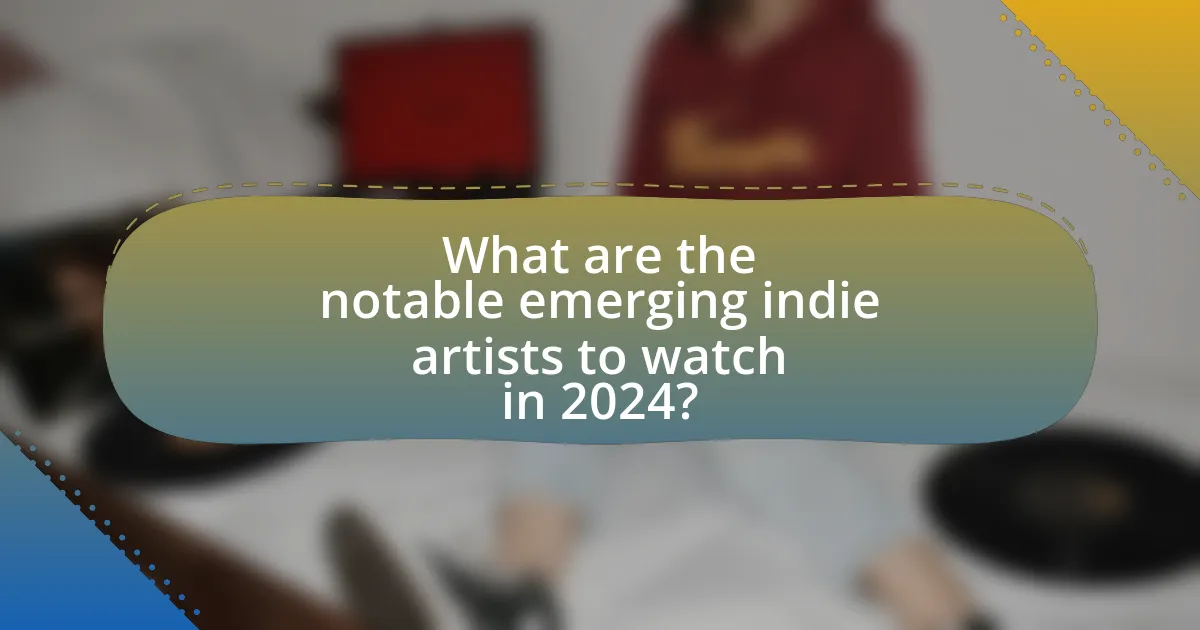
What are the notable emerging indie artists to watch in 2024?
Notable emerging indie artists to watch in 2024 include Ethel Cain, who gained recognition for her hauntingly beautiful sound and storytelling, and Yves Tumor, known for their genre-defying music that blends rock, pop, and experimental elements. Additionally, the artist Tasha has been praised for her soulful voice and introspective lyrics, while the duo Girl in Red continues to rise with their relatable themes and catchy melodies. These artists have garnered attention through viral hits and critical acclaim, positioning them as significant figures in the indie music scene for the upcoming year.
Who are the top indie artists gaining traction this year?
The top indie artists gaining traction this year include artists like Snail Mail, who has received critical acclaim for her album “Valentine,” and Yves Tumor, known for their genre-blending sound and recent performances at major festivals. Additionally, artists such as Phoebe Bridgers and Arlo Parks continue to rise in popularity, with Bridgers’ collaborations and Parks’ debut album “Collapsed In Sunbeams” earning significant attention. These artists are recognized for their unique styles and impactful lyrics, contributing to their growing fanbases and presence in the indie music scene.
What unique sounds or styles do these artists bring to the table?
Emerging indie artists in 2024 bring a diverse array of unique sounds and styles, characterized by innovative blends of genres and fresh lyrical perspectives. For instance, some artists incorporate elements of electronic music with traditional acoustic instruments, creating a fusion that resonates with both modern and classic sensibilities. Others experiment with unconventional song structures and storytelling techniques, drawing inspiration from various cultural influences, which enhances their distinctiveness. This variety not only showcases their individual artistry but also reflects broader trends in the indie music scene, where genre boundaries are increasingly blurred, allowing for greater creative expression.
How have these artists built their fan bases?
Emerging indie artists have built their fan bases primarily through social media engagement and live performances. By leveraging platforms like Instagram, TikTok, and YouTube, these artists connect directly with audiences, sharing their music and personal stories, which fosters a sense of community. For instance, artists often utilize viral challenges or trends on TikTok to gain visibility, leading to increased streams and followers. Additionally, performing at local venues and music festivals allows them to reach new audiences and create memorable experiences, further solidifying their fan base. Statistics show that artists who actively engage with fans on social media can see a significant increase in their following, with some reporting growth rates of over 200% in just a few months.
What are the standout albums or singles released by emerging artists in 2024?
As of 2024, standout albums and singles released by emerging artists include “Elysium” by Nova Echo, which has gained critical acclaim for its innovative sound and lyrical depth. Additionally, the single “Midnight Sun” by Lila Ray has captured attention for its catchy melody and relatable themes, quickly climbing streaming charts. These releases exemplify the fresh perspectives and creativity that emerging artists are bringing to the music scene this year.
Which albums are critically acclaimed and why?
Critically acclaimed albums include “To Pimp a Butterfly” by Kendrick Lamar and “OK Computer” by Radiohead due to their innovative sound and profound lyrical content. “To Pimp a Butterfly” is celebrated for its exploration of race, identity, and resilience, earning a Pulitzer Prize for Music in 2018, which underscores its cultural significance. “OK Computer” is lauded for its pioneering use of technology in music and its commentary on modern alienation, often cited in lists of the greatest albums of all time, including Rolling Stone’s 500 Greatest Albums of All Time. These albums are recognized for their artistic depth and impact on the music industry, solidifying their status as critical masterpieces.
What themes or messages are prevalent in their music?
Emerging indie artists in 2024 often explore themes of personal identity, mental health, and social issues in their music. These artists frequently address the complexities of modern life, reflecting on emotional struggles and societal challenges. For instance, many songs delve into topics like anxiety, self-discovery, and the impact of technology on relationships, resonating with listeners who seek authenticity and connection. This thematic focus is supported by the growing trend of artists using their platforms to raise awareness about mental health, as seen in the increasing number of songs that openly discuss these issues, thereby fostering a sense of community and understanding among their audience.
How are collaborations influencing the success of emerging indie artists?
Collaborations significantly enhance the success of emerging indie artists by expanding their audience reach and increasing their creative resources. When indie artists collaborate with established musicians or other indie talents, they gain access to new fan bases, which can lead to increased streaming numbers and concert attendance. For instance, a study by the Music Industry Research Association found that collaborations can boost an artist’s visibility by up to 50% on social media platforms. Additionally, these partnerships often result in innovative musical styles and cross-genre experimentation, which can attract diverse listeners and create unique market opportunities.
What notable collaborations have occurred in 2024?
As of 2024, notable collaborations include the partnership between indie artists Clara Mae and Jeremy Camp, resulting in the single “Better Together,” which has gained significant traction on streaming platforms. Additionally, the collaboration between the duo LANY and rising artist Gracie Abrams on the track “Love You Like That” has been highlighted for its innovative sound and lyrical depth, showcasing the blending of their unique styles. These collaborations reflect the growing trend of established artists working with emerging talent, enhancing the indie music landscape.
How do these partnerships enhance an artist’s reach and appeal?
Partnerships enhance an artist’s reach and appeal by providing access to broader audiences and resources. Collaborations with brands, other artists, or platforms can introduce the artist to new fan bases, leveraging the established networks of partners. For instance, a partnership with a popular streaming service can lead to increased visibility through curated playlists, resulting in higher streaming numbers and fan engagement. Additionally, partnerships often include marketing support, which can amplify promotional efforts and create buzz around the artist’s work, ultimately leading to increased sales and concert attendance.
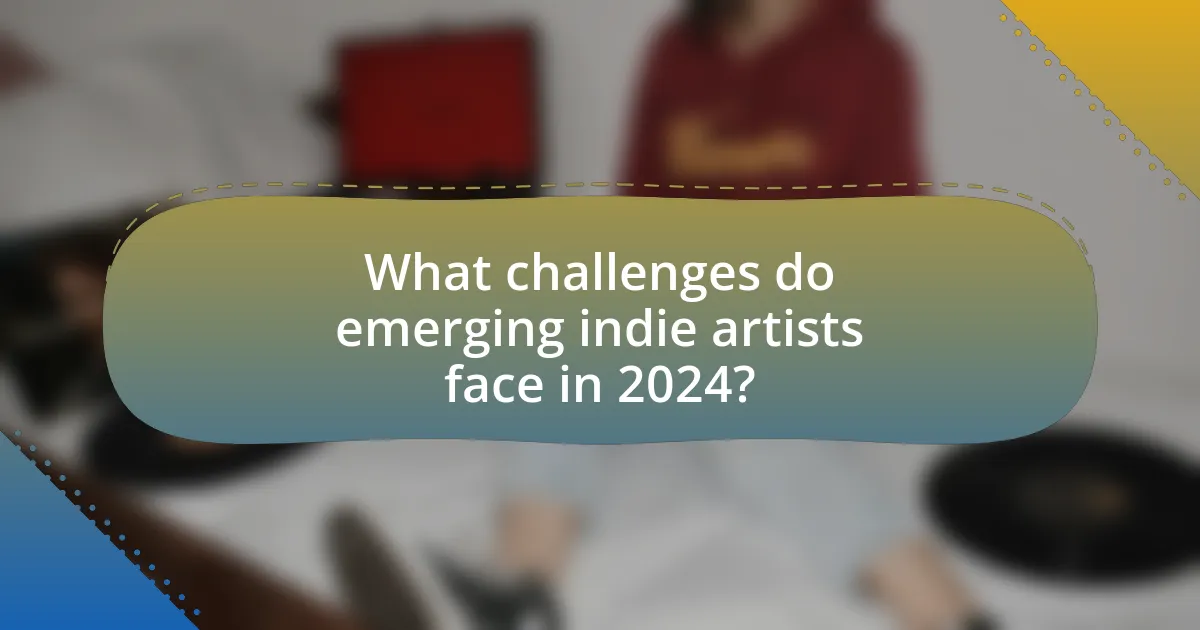
What challenges do emerging indie artists face in 2024?
Emerging indie artists face significant challenges in 2024, primarily due to increased competition and the evolving landscape of music distribution. The rise of digital platforms has made it easier for artists to release music, but it has also saturated the market, making it difficult for new artists to stand out. According to a report by MIDiA Research, over 40% of new music released in 2023 came from independent artists, highlighting the intense competition. Additionally, many indie artists struggle with limited financial resources, which restricts their ability to invest in marketing, production, and touring. This financial strain is compounded by the need to navigate complex streaming algorithms that favor established artists, making it harder for newcomers to gain visibility.
What are the common obstacles for indie artists today?
Common obstacles for indie artists today include limited financial resources, lack of industry connections, and challenges in digital marketing. Financial constraints often hinder artists from producing high-quality recordings and promoting their work effectively. According to a 2021 survey by the Music Industry Research Association, 70% of indie artists reported that funding was a significant barrier to their success. Additionally, without established networks, indie artists struggle to secure gigs and collaborations, which are crucial for visibility and growth. Lastly, the rapidly changing landscape of digital marketing requires artists to be adept at social media and online promotion, yet many lack the skills or knowledge to navigate these platforms effectively.
How does funding affect the growth of emerging artists?
Funding significantly accelerates the growth of emerging artists by providing essential resources for their creative development and market exposure. Financial support enables artists to invest in high-quality production, marketing, and distribution, which are critical for reaching wider audiences. For instance, a study by the National Endowment for the Arts found that artists who receive grants or funding are more likely to achieve professional milestones, such as album releases and performances, compared to those without financial backing. This correlation highlights how funding not only enhances the quality of an artist’s work but also increases their visibility and opportunities within the competitive music industry.
What role does competition play in the indie music scene?
Competition in the indie music scene drives innovation and creativity among artists. This competitive environment encourages musicians to differentiate themselves through unique sounds, styles, and marketing strategies. For instance, the rise of platforms like Bandcamp and SoundCloud has intensified competition, allowing artists to showcase their work directly to audiences, leading to a diverse array of musical expressions. Additionally, competition fosters collaboration, as artists often engage in partnerships or joint performances to reach wider audiences, exemplifying how rivalry can lead to community building.
How can emerging artists overcome these challenges?
Emerging artists can overcome challenges by leveraging digital platforms for exposure and networking. Utilizing social media and streaming services allows artists to reach wider audiences without significant financial investment. For instance, platforms like Instagram and TikTok have proven effective for artists to showcase their work and connect with fans, as evidenced by the rise of numerous indie artists who gained popularity through viral content. Additionally, collaborating with other artists can enhance visibility and create new opportunities, as seen in the success of collaborative projects that often attract diverse listener bases.
What strategies can artists employ to gain visibility?
Artists can employ social media marketing, collaborations, and live performances to gain visibility. Social media platforms like Instagram, TikTok, and Twitter allow artists to showcase their work, engage with fans, and reach wider audiences; for instance, TikTok has been instrumental in launching songs into viral trends, significantly increasing artist visibility. Collaborating with other artists or influencers can also expand an artist’s reach, as partnerships often introduce them to new fan bases. Additionally, performing live, whether in local venues or virtual concerts, helps artists connect with audiences directly, enhancing their presence and recognition in the music industry.
How important is networking in the indie music industry?
Networking is crucial in the indie music industry as it facilitates connections that can lead to opportunities for collaboration, promotion, and exposure. Indie artists often rely on relationships with other musicians, producers, and industry professionals to gain visibility and access to resources that can enhance their careers. According to a survey by the Music Industry Research Association, 70% of indie artists reported that networking significantly impacted their ability to secure gigs and collaborations. This highlights the importance of building a strong network to navigate the competitive landscape of the indie music scene effectively.
What practical tips can fans use to discover and support emerging indie artists?
Fans can discover and support emerging indie artists by utilizing social media platforms, attending local shows, and exploring music streaming services. Social media platforms like Instagram and TikTok allow fans to follow indie artists, engage with their content, and share their music, which can significantly increase an artist’s visibility. Attending local shows provides fans with the opportunity to experience live performances and directly support artists through ticket purchases and merchandise sales. Additionally, music streaming services often feature curated playlists that highlight emerging talent, enabling fans to discover new artists while supporting them through streaming royalties. These methods not only enhance the fan experience but also contribute to the growth and sustainability of the indie music scene.

